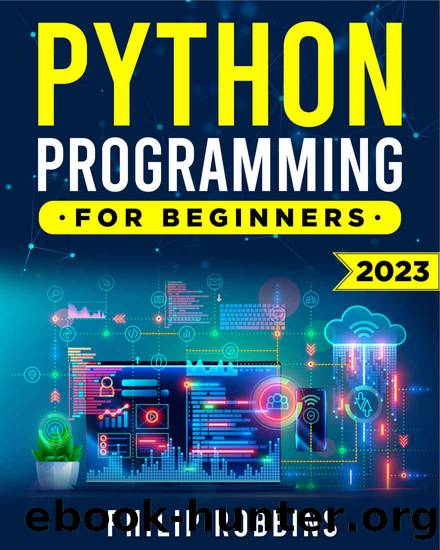Python Programming for Beginners: The Complete Guide to Mastering Python in 7 Days with Hands-On Exercises â Top Secret Coding Tips to Get an Unfair Advantage and Land Your Dream Job! by Philip Robbins

Author:Philip Robbins [Robbins, Philip]
Language: eng
Format: epub, azw3
Published: 2023-02-02T08:00:00+00:00
Tuples
Even though lists are popular data structures that Python programmers frequently use in their applications, they have several implementation issues. Because all lists created with Python are mutual objects, they are simple to replace, delete, or manipulate.
As a software developer, you may be required to keep immutable lists that cannot be altered in any way. That's why tuples exist. Within Tuples, it is not possible to change initiated elements in any way. When you try to change the content of a tuple, you will get a "Type Error" message.
Program Code:
# Let's create a tuple using Python
t = ('Cat', 'Tree', 'Apple')
print(t)
Output:
('Cat', 'Tree', 'Apple')
In the previous example, we simply initiated a tuple and used a print function to display it on the screen. Tuples, unlike lists, are not represented with square brackets, but rather with parenthesis to distinguish them from lists.
To understand how tuples work, try changing one of the elements in the preceding example and printing the tuple to see what happens.
Program Code:
t = ('Cat', 'Tree', 'Apple')
print(t)
Download
Python Programming for Beginners: The Complete Guide to Mastering Python in 7 Days with Hands-On Exercises â Top Secret Coding Tips to Get an Unfair Advantage and Land Your Dream Job! by Philip Robbins.azw3
This site does not store any files on its server. We only index and link to content provided by other sites. Please contact the content providers to delete copyright contents if any and email us, we'll remove relevant links or contents immediately.
| Coding Theory | Localization |
| Logic | Object-Oriented Design |
| Performance Optimization | Quality Control |
| Reengineering | Robohelp |
| Software Development | Software Reuse |
| Structured Design | Testing |
| Tools | UML |
Deep Learning with Python by François Chollet(12569)
Hello! Python by Anthony Briggs(9914)
OCA Java SE 8 Programmer I Certification Guide by Mala Gupta(9795)
The Mikado Method by Ola Ellnestam Daniel Brolund(9777)
Dependency Injection in .NET by Mark Seemann(9337)
Algorithms of the Intelligent Web by Haralambos Marmanis;Dmitry Babenko(8296)
Test-Driven iOS Development with Swift 4 by Dominik Hauser(7763)
Grails in Action by Glen Smith Peter Ledbrook(7696)
The Well-Grounded Java Developer by Benjamin J. Evans Martijn Verburg(7557)
Becoming a Dynamics 365 Finance and Supply Chain Solution Architect by Brent Dawson(7065)
Microservices with Go by Alexander Shuiskov(6826)
Practical Design Patterns for Java Developers by Miroslav Wengner(6746)
Test Automation Engineering Handbook by Manikandan Sambamurthy(6690)
Secrets of the JavaScript Ninja by John Resig Bear Bibeault(6413)
Angular Projects - Third Edition by Aristeidis Bampakos(6093)
The Art of Crafting User Stories by The Art of Crafting User Stories(5618)
NetSuite for Consultants - Second Edition by Peter Ries(5558)
Demystifying Cryptography with OpenSSL 3.0 by Alexei Khlebnikov(5363)
Kotlin in Action by Dmitry Jemerov(5062)
